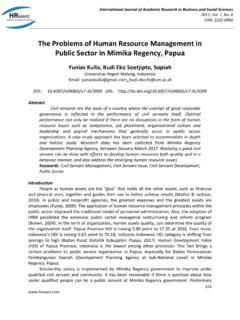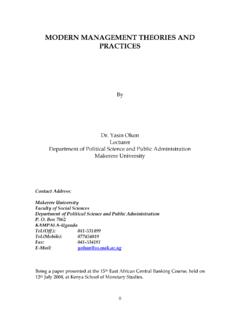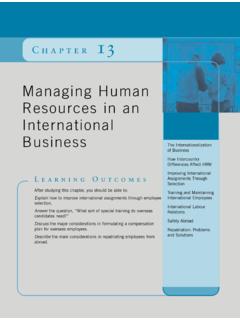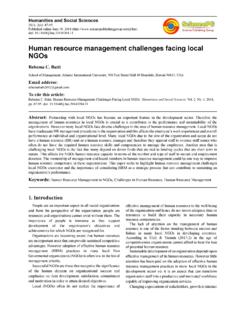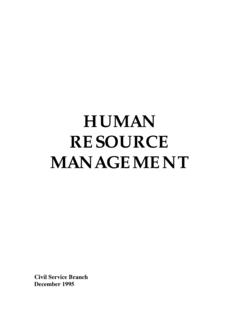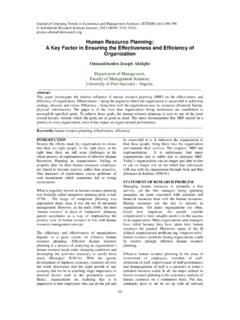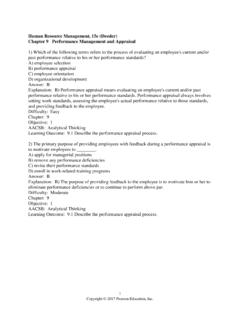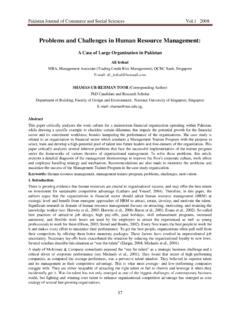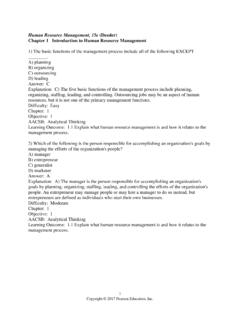Transcription of Use of Case Study Methods in Human Resource …
1 30-2 Use of Case Study Methods in Human Resource management , development , and training Courses: Strategies and Techniques James R. Maxwell, Anthony F. Gilberti, and Davison M. Mupinga Indiana State University This paper will Study some of the problems associated with case studies and make recommendations using standard and innovative methodologies effectively. Human Resource management (HRM) and Resource development cases provide context for analysis and decision-making designs in different industries. In most HRM development and training courses students use cases about actual companies to practice strategic HRM analysis and to gain some experience in the tasks of crafting strategies and implementing HRM training and development : Case Study , training and development , Human Resources The case method is an effective avenue for sensitizing students and faculty to the complexities and structures of entrepreneurial business organizations and leadership situations.
2 Business cases are one of the most effective and convenient ways to introduce practice into the classroom, to tap a wide variety of experiences, and involve students actively in analysis and decision-making. Cases are not intended as examples of either weak or exceptionally good management practices. Nor do they provide examples of particular concepts. Faculty that utilize case analysis Methods are up-dated as to current techniques, successes and failures of business allowing them to stay case approach to strategic analysis is, first and foremost, an exercise in learning by doing. Cases help substitute for on-the-job experience by (1) giving you broader exposure to a variety of industries, organizations, and strategic problems; (2) forcing you to assume a managerial role (as opposed to that of just an onlooker); (3) providing a test of how to apply the tools and techniques of Human Resource management , development , and training ; and (4) asking you to come up with pragmatic managerial action plans to deal with the issues at hand.
3 Cases attempt to reflect the various pressures and considerations that professionals of all varieties confront in the workplace (Stanford University, 1994). Using complex, realistic open-ended problems as a focus, cases are designed to challenge you and help you develop and practice skills that you may need in your future careers. Cases are also an excellent way to see how abstract principles learned in class are applied to real world situations. Additional reasons to use case studies:1. Learn Different Perspectives - Group discussion can help you understand how others might view an issue and what the valid points are. 2. Real-life Scenarios - Cases allow students to apply classroom principles to real situations. 3. Solve Ambiguous Problems - Few problems in the real world are as clean cut as those in a textbook. Cases can help you develop skills to analyze the more complex problems you may encounter later.
4 4. Sort and Analyze Ambiguous Data - Case studies can help you learn strategies for sorting out seemingly unconnected bits of data and organizing them to understand the problem. 5. Communication Skills - Both group discussion and writing an analysis of the issues can improve your writing and speaking skills. 6. Identify Your Own Assumptions - Learning what your core assumptions in life are can help you understand what emotional reactions you may have to certain issues and help consider whether they are valid or not Cases Replicate RealityThe case method is based on the principle that learning occurs most when people teach themselves through working on their own problems. You will gain a greater understanding and improve judgment skills when you work through an issue instead of just listening passively to a lecture. Many cases center-around an ill-structured collection of ambiguous (occasionally contradictory) facts, opinions, incidents and documents which you must organize into a coherent whole in order to analyze the problem and provide a viable solution.
5 Like any expert, you will approach cases under the pressure of time, on the basis of Copyright 2006 James R. Maxwell, Anthony F. Gilberti & Davison M. Mupinga 62630-2limited facts and when facing the unknown. You may also be working on a case with other people whose opinions may differ from your own. You never have all the facts you would like and will have to exercise your best judgment which can be improved by discussion and consultation with others. Experiencing this process can be frustrating and confusing, but it is also practical and Elements Cases come in many shapes and sizes from a simple "What would you do in this situation and so what?" question to an elaborate role-playing scenario in which students must resolve a complex questions based on real-world data and documents. How simple or elaborate a case is depends on what you want your students to be able to do in the of Case Studies Many courses use case studies in their curriculum to teach content, involve students with real life data or provide opportunities for students to put themselves in the decision maker's shoes.
6 Some of the primary benefits include: 1. Real World Context - Not only do students see how the course material applies to the world outside the classroom, but they get to see how data is often ambiguous or not clearly defined in many situations. 2. Explore Multiple Perspectives - Cases in which a decision is required can be used to expose students to viewpoints from multiple sources and see why people may want different outcomes. Students can also see how a decision will impact different participants, both positively and negatively. 3. Requires Critical Thinking and Analysis - Cases usually require students to analyze data in order to reach a conclusion. Since many assignments are open-ended, students can practice choosing appropriate analytic techniques as well. 4. Students Synthesize Content - Many cases require students to pull in different analytic techniques and information from different areas of the course in order to provide an effective solution to the problem.
7 In addition, a case assignment can require an initial statement of the facts and techniques used to reach the conclusion. Recommendations for Using Cases There are many ways to use cases. Some instructors prefer to generate open class discussion. Others prefer to assign cases to student teams for oral presentations (Stanford University, 1994). Most like to have students write an analysis of the case, often as a final examination. Some other techniques and Methods follow. Case studies include a scenario, statement of the issues or problem(s), and a required assignment. There is no one best case Study method for all situations. The following are some of the various case Study types available for use. Types of Case Analyses Class Case Discussion One approach is for the instructor to lead the discussion with penetrating questions and answers. Many strategic management , entrepreneurship and marketing professors like to begin the analysis with a few key questions and hope to get the students to take over the discussion (Penn State, 2006).
8 Some suggested steps for class case discussion: 1. Read the case over carefully before class. Review financial data, adjusting for inflation. 2. Define your objectives before entering the class. Identify key points. Organize the class into teams and have them role-play or analyze certain parts of the case and present them to the class. 3. Begin with basic information. Have a student identify the facts of the case. Request students to describe the firm. 4. Outline on the chalkboard or whiteboard key material or points. Under each key point, identify alternatives with pros and cons for each. Force the class to make a decision. At the end of each class, sum up the discussion and to point out the key learning objectives of the case discussion. 5. Do not to carry a case over to the next class meeting. Students will forget and it will eliminate valuable time for your next class gathering.
9 6. Explain what the outcome was to the students at the end of the Oral Presentations Another approach commonly used with case studies is student oral presentations. Place the students into teams, each composed of three to five people. Each team is assigned a case to present during the semester. This approach may be used during the second half of the semester if the instructor chooses to lead open discussion during the first half. It may also be used during the first half instead of open class case discussion if a simulation or project is planned for the second half of the course. Written Case Analysis There are at least three approaches to use with written case analyses. One is the comprehensive student report that covers all the issues in the case. A second approach is the short report prepared in response to a specific question. A third approach is the strategic audit that is only a three- to five- page outline for expediency.
10 Grading of Written Comprehensive Case Reports The grading of a written and oral comprehensive report is often aided by the use of a case evaluation forms. Items to be addressed in the form or legibility, length of report, organization of report, spelling and use of grammar, effectiveness of writing style, use of references and exhibits, environmental scan assessment, achievement of goals and objectives, strategy formulation, implementation and audit assessment and recommendations. Written assignments can easily be developed using discussion questions and teaching notes for each Play A common type of case assignment in which students are assigned roles to play in a scenario. Some scenarios can include developing a business plan or staging a mock trial; other role play scenarios can involve controversial issues. Role-playing is one way students can express different views in a relatively safe classroom climate.










